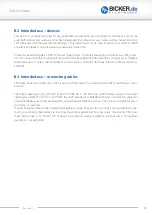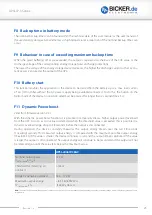
UPSI-IP-3 Series
Revision 1-0
24
F5 Initial operation
The correct installation of the UPS has to be ensured.
The device starts as soon as it is connected to AC voltage (100…240 V AC nominal) via the AC input line. The
voltage is converted internally to 24 V DC and passed on to the UPS module. The energy storage device is que-
ried and transmits its data. The end-of-charge voltage is set and the memory is released. The charging process
of the energy store then begins.
Reduced by a current-dependent voltage drop, the 24 V DC voltage is forwarded to the output. The device
charges the energy storage and at the same time monitors the voltage thresholds/voltage values at the input
(UPS function).
It must be ensured that the system or the power grid supplies enough power to guarantee normal operation
(without charging) as well as charging („Dimensioning the upstream fuse“).
F6 Charging time
Charging time depends on operating temperature and load current
F7 Overcurrent / Short circuit / Overtemperature protection
Overcurrent:
If the load current at the output is too high, the device switches it off. For maximally allowed current values
and peak current values refer to chapter D „Technical Data”. The status LED indicates the error status by means
of a very rapid flashing sequence. A restart attempt occurs every 10 seconds in normal mode. During battery
mode there is no restart attempt.
Short circuit:
In the event of a short-circuit at the output of the UPS, the output is immediately disconnected (<5 ms). The
status LED indicates the error status by means of a very rapid flashing sequence. A restart attempt occurs every
second in normal mode (non-latch). During battery mode there is no restart attempt. The impact of a short-
circuit to the device depends on length and diameter (impedance) of the output wiring. In case of a short-circuit
directly at the device output a damage of the device can occur.
Overtemperature protection:
A temperature sensor is located on the AC/DC converter board, which checks the internal temperature If this
increases due to a defect, malfunction, incorrect use, etc., the overtemperature protection is triggered above a
critical value and switches off the AC/DC converter until the value has dropped below a certain value (only in
normal mode, not in battery mode!). The built-in battery is also monitored. The charging or discharging process
is interrupted if the values are outside the specification








































